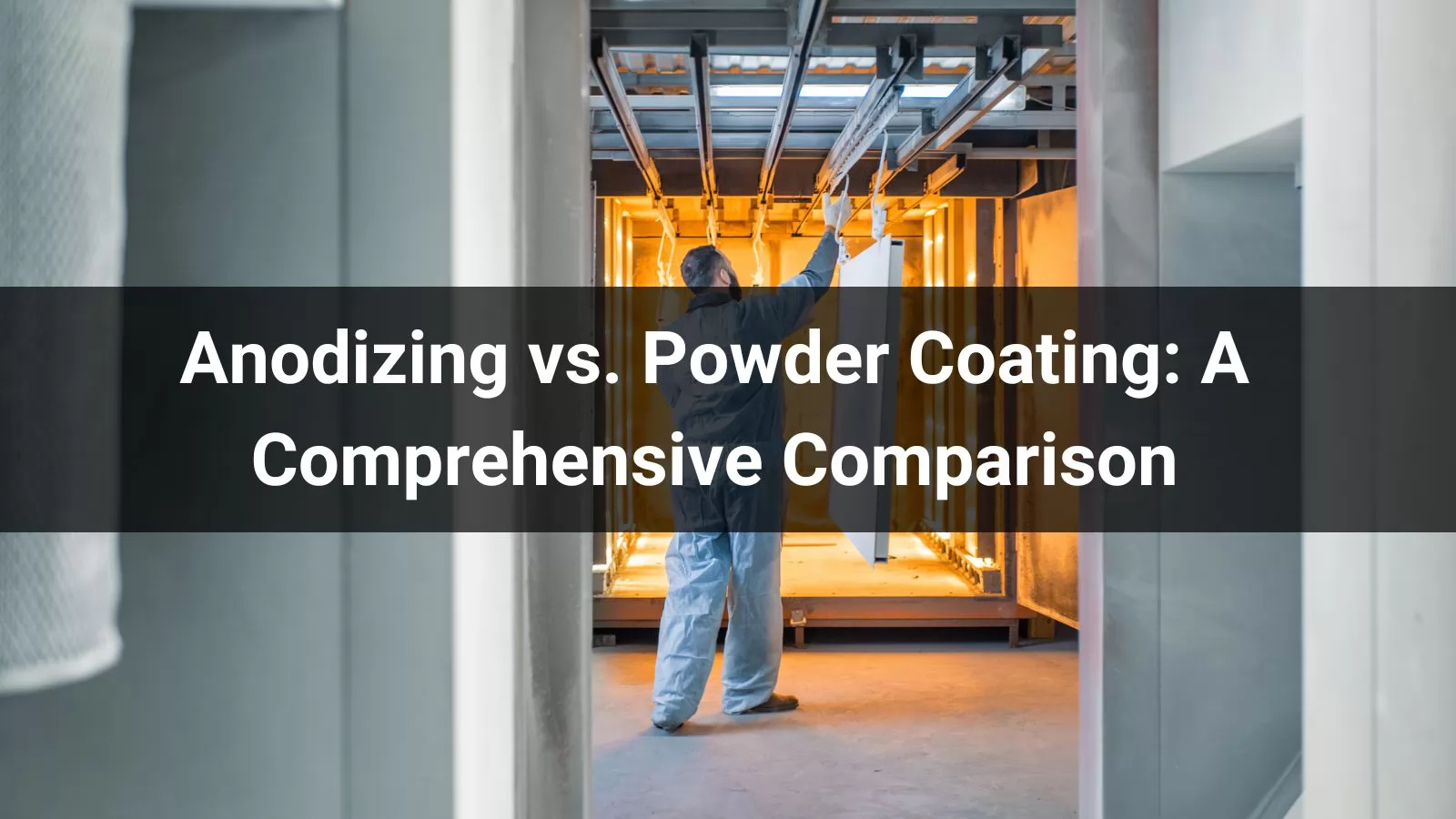
.png)
.png)


-
.png) 0086-757-85407388
0086-757-85407388 -

-
 terrychen@wintoly.com
terrychen@wintoly.com


.png)
.png)


.png)




When it comes to finishing metal surfaces, anodizing and powder coating are two of the most popular options. Both offer distinct advantages and are used for different purposes, depending on the specific requirements of the project. Whether you’re looking for durability, aesthetic appeal, or protection against corrosion, understanding the differences between these two processes can help you make an informed decision for your next project.
In this blog, we will explore anodizing and powder coating, comparing their benefits, applications, and the key factors to consider when choosing the right finishing technique for your metal surfaces.
Anodizing is an electrochemical process that transforms the surface of metal—most commonly aluminum—into a durable, corrosion-resistant oxide layer. Unlike traditional coatings, anodizing creates a bond between the metal and the oxide layer, which means it doesn’t peel or chip off. This layer can be porous, allowing for the addition of dyes or pigments, but still maintains the metal’s natural texture and appearance.
Key Features of Anodizing:
One of the standout features of anodizing is its durability. The process forms a tough oxide layer on the surface of the metal, which is significantly harder than the base material itself. This layer is highly resistant to wear, scratching, and corrosion, making anodized surfaces ideal for products exposed to rough handling or extreme environmental conditions. Anodizing also offers a variety of aesthetic options. While it preserves the natural metallic appearance, the oxide layer can be dyed in a wide array of colors, giving it versatility for a range of design preferences. This makes anodizing a popular choice for both functional and decorative applications. Additionally, anodized surfaces exhibit excellent environmental resistance. They can withstand extreme weather conditions, UV rays, and exposure to harsh chemicals without deteriorating, ensuring that products remain intact and visually appealing over time. Furthermore, anodizing is a non-toxic and eco-friendly process, as it does not require harmful chemicals, unlike other surface treatments. This makes it a sustainable choice for manufacturers looking to minimize their environmental impact while still achieving high-quality finishes.
Common Applications:
Anodizing is widely used across various industries due to its robust properties. In architectural elements, anodized aluminum is commonly employed in the construction of buildings and structures, including window frames, curtain walls, and decorative panels. Its ability to resist corrosion and maintain its appearance over time makes it perfect for high-traffic, exposed areas that are susceptible to the elements. In the field of consumer electronics, anodizing is often used for components like mobile phones, computers, and cameras. The process enhances the durability of these devices, protecting them from scratches and corrosion, while also providing an attractive finish. Additionally, automotive parts frequently benefit from anodizing. The process is used to create lightweight, durable, and attractive finishes for various automotive components, such as trim, wheels, and engine parts. Anodizing helps automotive manufacturers achieve a high-performance finish that is both functional and visually striking, improving the longevity and aesthetic appeal of vehicles.
Overall, anodizing’s combination of strength, visual versatility, and environmental resilience makes it a popular choice for a wide range of industries, from construction and electronics to automotive and beyond.
Powder coating is a dry finishing process that involves applying a powdered paint (made of resin, pigment, and additives) to the metal surface using an electrostatic charge. The metal object is then heated in an oven, causing the powder to melt and form a smooth, solid coating. The result is a hard, durable finish that is resistant to corrosion, weathering, and abrasions.
Key Features of Powder Coating:
Common Applications:
Process and Application:
Durability:
Appearance:
Environmental Resistance:
Cost:
Environmental Impact:
When deciding between anodizing and powder coating, the specific needs of your project will guide your choice. Choose anodizing if you are working with aluminum and require a long-lasting, corrosion-resistant finish. Anodizing is particularly well-suited for aluminum because it enhances the metal's natural properties, providing excellent protection against oxidation without compromising its structural integrity. If you need a finish that preserves the natural look and texture of the metal, anodizing is the way to go. The process creates a hard oxide layer that is transparent, allowing the original appearance of the aluminum to shine through while still providing enhanced durability. Additionally, anodizing is ideal for outdoor or architectural applications due to its superior UV resistance. The anodized surface resists fading from the sun and harsh environmental conditions, making it perfect for use in windows, facades, and other exposed building elements.
On the other hand, choose powder coating if you're looking for a wide range of color options and finishes. Powder coating offers an extensive selection of colors and finishes—from glossy to matte, metallic to textured—which gives you more flexibility in achieving the exact look you desire. It’s also a versatile option if you're working with a variety of metals, such as steel or iron, as powder coating can be applied to different substrates. In addition to its aesthetic versatility, powder coating is ideal if you require a thicker, impact-resistant coating. The thick layer formed during the powder coating process provides enhanced protection against scratches, chips, and general wear, making it a preferred choice for automotive parts, industrial machinery, and consumer products that are exposed to rough handling and heavy use. Whether you're designing a product for durability or aiming for a vibrant, long-lasting finish, powder coating can deliver the performance and aesthetic appeal you're looking for.
Anodizing and powder coating are both widely used surface treatment methods, but each has its own unique characteristics, making one more suitable than the other depending on the specific application.
Anodizing is an electrochemical process that forms a durable oxide layer on the surface of metals, primarily aluminum. The anodized layer enhances the metal's resistance to corrosion, wear, and abrasion, making it ideal for use in harsh environments. One of the primary advantages of anodizing is its ability to retain the metal’s natural appearance, while providing enhanced durability. The finish is highly resistant to scratches, fading, and environmental degradation. Anodizing also offers excellent corrosion resistance, making it particularly useful for outdoor applications such as in aerospace, automotive, and architectural industries. Additionally, anodizing is non-toxic and environmentally friendly, as it does not release harmful chemicals during the process. However, the color options for anodizing are more limited compared to powder coating, and the finish is often more subtle or metallic.
Powder coating is a dry finishing process where a powdered paint is applied to a surface and then cured under heat to form a solid, durable coating. It is widely used on metals such as aluminum, steel, and other materials. One of the key benefits of powder coating is the wide range of color and texture options available, including matte, glossy, and textured finishes. It is also highly resistant to chipping, scratching, and fading, making it an excellent choice for applications that require both aesthetics and durability. Additionally, powder coating is an environmentally friendly process because it does not involve the use of solvents. It also provides a cost-effective solution for mass production, especially when applied to simple, flat surfaces. However, powder coating does have some limitations, such as the potential for a thicker finish that may affect dimensional tolerances and the brittleness of the coating, which can cause cracks or chips under certain conditions.
Despite its numerous advantages, powder coating has several limitations. First, the process can result in a thicker finish compared to other coatings, which might affect the precise tolerances required for certain applications. Additionally, while powder coating is tough and durable, it can be brittle, which makes it susceptible to cracking or chipping when subjected to significant impact or bending. Powder coating is also limited to materials that can withstand high temperatures, as the curing process requires temperatures around 180–200°C. This means that it cannot be used on heat-sensitive materials or components. Furthermore, while powder coating is highly resistant to wear, it can still experience fading or chalking over time when exposed to prolonged UV light, particularly on outdoor surfaces. Lastly, the quality of the powder coating depends heavily on proper surface preparation; any contamination or lack of cleanliness can result in defects in the final coating.
Anodizing also has its drawbacks. One of the primary limitations is its relatively narrow color range compared to powder coating. While anodized finishes can be metallic or subtle in color, the variety of available shades is much more limited. Another disadvantage is that anodizing can sometimes reduce the inherent strength of the base metal, especially if the anodized layer is not sufficiently thick. This can affect the mechanical properties of the material. Furthermore, anodizing is typically limited to aluminum and certain titanium alloys, meaning it cannot be applied to other types of metal, such as steel. Additionally, anodizing can be more expensive for larger items, as the process requires specialized chemical baths and the use of electricity, making it cost-prohibitive for mass production of large parts or products.
When it comes to cost, powder coating is generally considered to be the more affordable option, particularly for large-volume projects. It can be applied quickly and efficiently to a wide variety of products, making it an economical choice for manufacturers. Anodizing, on the other hand, is a more specialized process, especially when applied to metals like aluminum. The additional steps, such as the need for chemical baths and precise control of the process, often make anodizing more expensive than powder coating. However, for high-end applications where durability, corrosion resistance, and a natural metallic finish are crucial, the additional cost of anodizing may be justified.
In summary, the choice between anodizing and powder coating depends on the specific needs of the project, including the required finish, durability, material type, and budget.
Both anodizing and powder coating offer exceptional benefits depending on the specific requirements of your project. Anodizing excels in enhancing the natural look of aluminum while providing excellent corrosion resistance, making it ideal for architectural and high-performance applications. Powder coating, on the other hand, offers superior color variety and impact resistance, making it a great choice for products that require a durable, aesthetic finish.
By understanding the key differences and benefits of each process, you can choose the best option to ensure your metal products have the right finish for long-lasting durability and visual appeal.
For those seeking high-quality powder coatings, Wintoly coating is a leading specialized manufacturer in China. With over 20,000 square meters of production space, Wintoly coating is committed to delivering durable, vibrant, and innovative powder coating solutions. Whether you need coatings for industrial, automotive, or architectural applications, Wolong Chemical provides reliable and high-performance products tailored to your specific needs.Contact us now!
Read More:
Origins and Values of Leading Powder Coating Brands: Tiger Drylac and Asian Paints
Top 10 Powder Coating Companies in South Africa (Updated 2025)

 terrychen@wintoly.com
terrychen@wintoly.com
.png) 0086-757-85407388
0086-757-85407388
 6 Chaoyang Rd., National Demonstration Eco-industrialzone, Nanhai, Foshan,Guangdong,China
6 Chaoyang Rd., National Demonstration Eco-industrialzone, Nanhai, Foshan,Guangdong,China

.png)
